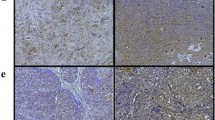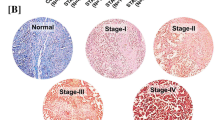Abstract
Objectives: Ovarian cancer has the highest mortality of all the gynecologic cancers. The antitumor agent paclitaxel has been proved to be efficient in the treatment of ovarian cancer. Our study is to develop a polymeric drug delivery system for paclitaxel and determine whether paclitaxel nanoparticle can inhibit growth of ovarian carcinoma xenografts in Fisher344 (F344) rats by intraperitoneal administration. The mechanism of paclitaxel nanoparticles in rats bearing ovarian cancer has been investigated in this study. Methods: Synthesize paclitaxel loading nanoparticle (PLA) by ultrasonic emulsification; MTT analysis identified cytotoxic activity of paclitaxel nanoparticle in vitro; rat ovarian carcinoma cells were injected into the peritoneal cavity of F344 rats. The antitumor effect of paclitaxel nanoparticle in vivo has been evaluated by measuring tumor weight and ascite volume. At the end of the procedure rats were sacrificed; tumors were excised and processed for PCNA staining, tissue terminal deoxynucleotide transferase-mediated dUTP nick and labeling assay and RT-PCR to evaluate the proliferative and apoptotic changes and cancer transfer-related gene expression induced by PLA. Paclitaxel concentration in plasma, pelvic lymph nodes, liver, and heart were determined by high-performance liquid chromatography. Results: Paclitaxel nanoparticle and PTX (Cremophor) showed equivalent cytotoxic activity in vitro. In rats implanted carcinoma cells, paclitaxel nanoparticles significantly reduced tumor weight and ascites volume, and induced apoptosis of tumor cells. PLA also inhibited cell proliferation and matrix metalloproteinase 9 mRNA expression. The paclitaxel concentration of pelvic lymph nodes in PLA treated animals was 20-fold higher than that of free PTX treated animals at 48 h after intraperitoneal administration. Conclusion: The intraperitoneal administration of paclitaxel nanoparticle can significantly inhibit the progression of ovarian carcinoma in peritoneal cavity of female F344 rat. The paclitaxel nanoparticle is safe and lymphatic targeting.








Similar content being viewed by others
References
Ozols R (1999) Treatment of gynecologic cancer: the US experience. Tumori 85:S5–S11
Gelderblom H, Verweij J, Nooter K, et al (2001) Cremophor EL: the drawbacks and advantages of vehicle selection for drug formulation. Eur J Cancer 37:1590–1598
Klooer JS, den Bakker MA, Gelderbolm H, et al (2004) Fatal outcome of a hypersensitivity reactions to paclitaxel: a critical review of premedication regimens. Br J Cancer 90:304–305
Wang YM, Sator H, Dachi I, et al (1996) Preparation and characterization of poly(lactic-co-glycolic acid) microspheres for targeted delivery of novel anticancer agent, taxol. Chem Pharm Bull (Tokyo) 44:1935–1940
Alex S, Charity DS, Vuong T, et al (2005) Comparative preclinical and clinical pharmacokinetics of a Cremophor-free, nanoparticle Albumin-bound paclitaxel (ABI007) and paclitaxel formulated in Cremophor (taxol). Clin Cancer Res 11:4236–4143
Dedrick RL, Myers CE, Bungay PM, et al (1978) Pharmacokinetic rationale for peritoneal drug administration in the treatment of ovarian cancer. Cancer Treat Rep 62:1–11
Philippe M, Pierre T, Claude A, et al (1992) Lymphatic targeting of polymeric nanoparticles after intraperitoneal administration in rats. Pharm Res 9:1534–1539
Markman M, Rowinsky E, Hakes T, et al (1992) Phase I trial of intraperitoneal taxol: a Gynecologic Oncology Group study. J Clin Oncol 10:1485–1491
Francis P, Rowinsky E, Schneider J, et al (1995) Phase feasibility and pharmacologic study of weekly intraperitoneal paclitaxel: a Gynecologic Oncology Group pilot study. J Clin Oncol 13:2961–2967
Yun M, Lee YL (2005) Preparation and in vitro anticancer activity of wheat germ agglutinin (WGA)-conjugated PLGA nanoparticles loaded with paclitaxel and isopropyl myristate. J Control Release 107:30–42
Fonseca C, Simoes S, Gaspar R (2002) Paclitaxel-loaded PLGA nanoparticles: preparation, physiochemical characterization and in vitro anti-tumoral activity. J Control Release 83:273–286
Mu L, Feng SS (2002) Vitamin E TPGS used as emulsifier in the solvent evaporation/extraction technique for fabrication of polymeric nanospheres for controlled release of paclitaxel (taxol). J Control Release 80:129–144
Joanna MK, Paul RL, David DA, et al (2004) Paclitaxel nanoparticles for the potential treatment of brain tumors. J Control Release 99:259–269
Hamaguchi T, Matsumura Y, et al (2005) NK105, a paclitaxel-incorporation micellar nanoparticle formulation, can extend in vivo antitumour activity and reduce the neurotoxicity of paclitaxel. Br J Cancer 92:1240–1246
Olin T, Saldeen T (1964) The lymphatic pathways from the peritoneal cavity: a lymphangiographic study in the rat. Cancer Res 24:1700–1711
Author information
Authors and Affiliations
Corresponding authors
Rights and permissions
About this article
Cite this article
Lu, H., Li, B., Kang, Y. et al. Paclitaxel nanoparticle inhibits growth of ovarian cancer xenografts and enhances lymphatic targeting. Cancer Chemother Pharmacol 59, 175–181 (2007). https://doi.org/10.1007/s00280-006-0256-z
Received:
Accepted:
Published:
Issue Date:
DOI: https://doi.org/10.1007/s00280-006-0256-z




